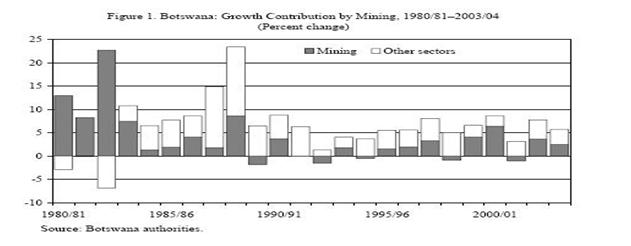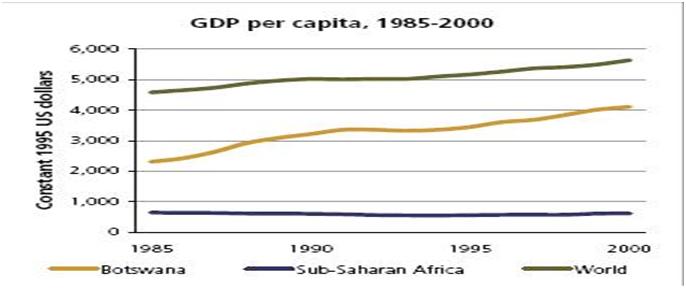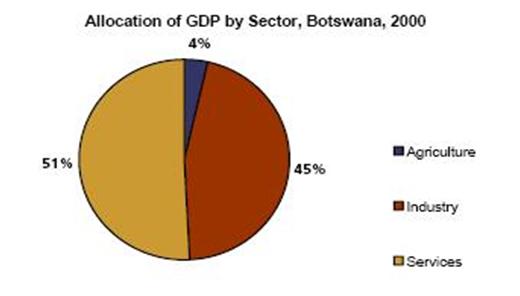The resource curse
By D.A Parker
Is an abundance of natural resources an impediment to Development?
Introduction
This paper argues that resources are not in themselves an impediment to development but over reliance on them and bad management is. There is an on-going debate amongst academics and political figures about the actual cause of the’ resource curse’. Using Botswana as an example of success contrasted against those that have fared less well it can be shown that for many people, even in the most successful resource dependent economies that have shown unparalleled development and economic growth, abundant resources can still be an unavoidable curse.
The resource poverty conflict Trap
An abundance of resources should be a blessing to a developing country however, for much of the developing world they have proved to be more of a curse than a blessing, doing more harm than good. Many parts of Africa and Asia find themselves in constant cycles of under-development, poverty and conflict (Collier, 2007).
The abundance of natural resources has been an aggravating factor against lasting peace and stability. Constant conflicts occur across the undeveloped world. Political and quasi-political forces struggle to control both extraction and supply or natural resources to finance their struggle against oppositional forces. Volatile situations arise which often involve several warring factions within a single region all fighting for autonomy over resources. Resources finance their struggles for identity, sovereignty, or political power over the whole country or specific region. Increasingly contemporary conflicts are over religious ideology. It is the natural resources that are financing these conflicts and it is the rest of the world mainly the west and increasingly China, that are buying them (Velleng, F, 2006: et al). A group that controls the resource’s and has ability to sell or trade them for arms can gain the upper hand with the obvious effect of prolonging the conflicts.
Contemporary conflicts are no longer a simple struggle between two opposing forces culminating with a single victor. Modern day conflicts involve many sides with varying ideals and philosophies often with more than just sovereignty at stake. An abundant resource adds yet another layer of complexity to theses struggles. After the fighting is over in many in cases the warring factions have to go on living side by side long after the violence subsides. To obtain any lasting peace involves a long process of negotiations, reconciliation and development. Sudden discoveries of resources have the tendency of negating efforts of reconciliation by attracting opportunist and rekindling old conflicts.
Africa is a rich and diverse continent with an abundance of natural recourse buried beneath the ground, yet it is also the poorest continent and the most violent, conflicts and tyranny reigns from the north to south. Amongst all the turmoil there are glimmers of hope, countries like Botswana for example doing considerable well out there natural resources presumably escaping the resource curse? At least that is the image that the country likes to portray to the rest of the world. However, the truth is far from that of the corporate image they portray. For the San Bushman diamonds are as big a curse as in the Congo or Liberia. For the Bushman there is as much blood on Botswana diamonds as anywhere else where resource conflicts exists, despite how much wealth the rest of the country may accumulates or spend(Good, 2005).So can Botswana truly be considering a success story or do we just forget about the Bushman and say it is?
So why do so many resources rich countries fail whilst others do apparently well. One argument blames “Dutch disease” (Ross, 1999: p8-10: Collier, 2007 : p40-42: et al). Dutch disease happens when a government fails to invest in other areas of the economy and rely too heavily on the resource. This has the effect of making other areas of the economy too costly and unprofitable. Dependency theory such as Raul Prebisch (1950) & Singer (1950) et al, (cited:Frankel, 2010: p5), suggest that over reliance on a single commodity or on natural resources means that the economy is open to market fads and fluctuations in the market mechanism. Meaning that when the international commodity prices fall the economy with too great a reliance on a single resource will fail. This as Collier (2007) suggest is part of the boom and bust cycle that many underdeveloped countries face creating cycles of peace, prosperity, poverty, and war.
Another problem suggests Collier (2007), is when a poor country suddenly discovers an abundance of resource, it is only natural that they borrow heavily and to invest in its extraction. This sudden growth in Government coffers can be another trap. For many, as in the Congo and Liberia for example, it can be seen by political opposition groups as a honeypot and an opportunity, this can lead to conflict before extraction of resource even starts.
As Kolstad and Rosser (2009) argue that it is the type and availability of the resource. The easier it is to extract the more open it is to exploitation. Comparing the Congo’s surface diamonds to Botswana deep diamonds is possible evidence for this argument. This is considered as rents the higher the cost of extraction the less likely rebel groups will invest in its extraction. Rebel groups are opportunist when it comes to gaining wealth to finance their wars; consequently they are less likely to invest in extraction technologies. Likewise oil that is onshore is harder [but not impossible], to exploit than oil found inland (Kolstad and Wiig, 2009). “The key idea in this class of explanation is that easy money corrupts”… (Sandbu, 2006: p1155). The Nigerian scenario is case in point, where whole regions are be plundered and exploited by both the corrupt government, privateers and gangs alike, with little returns going back into the state coffers, or used for further development. This along with chronic poverty and immense corruption and violence in most other areas of business leaves Nigeria and especially Lagos the capital amongst the top most dangerous places in the world to live in (Meredith, 2005).
Mineral- rich Government’s enjoying high revenues from resource exports “generally spend unusually large sums on their military forces” (Ross 2003:p25: cited: Good, 2005: p 7). This is no different of peaceful countries either. In Botswana for example, military spending increased significantly in Botswana during 1990s, rising from “P214 million (Pula) in 1992 to P625 million in 1995, representing slightly less than 5 per cent of GDP” (op. cit.). This
amount is not only higher than in any of its neighbouring countries, but is also “bigger than the United States” (ibid). Botswana is considered a peaceful country that has never been to war, perhaps it is paranoia having strong neighbour’s on one side like South Africa and weaker unstable neighbours like Zimbabwe on the other side, that makes them want to spend so much on military. As s(Rosser, (2006 ) suggest ‘resource abundance, authoritarianisms, despotism, military expenditure and civil war go hand in hand although this has yet to be fully proven it appears likely. As (Sandbu, (2006) ) suggest that by using economic measures that properly reflects the countries reliance on natural resources, rather than using absolute measure such as gross domestic product (GDP) or other percentile growth figures, there is ‘clear evidence of a resource curse’ “It manifests itself not only in slower economic growth, but also in higher risk of violent conflict” (Collier & Hoeffler, 1998: Fearon & Laitin, 2003 cited Sandbu, 2006: p1154).
So it would appear that even successful resource rich countries have blood on their hands in one way or another. Non- have completely escaped from the curse of buried wealth, not even the countries that have succeed in developing their economies and remained apparently peaceful like Botswana. The exploitation and inhumane treatment of indigenous communities by forced resettlement and pollution of their lands in order to get at and extract resource is not restricted to Botswana. In fact in most resource rich regions of the world similar treatment to that of the Bushman can be found. In Mexico, Brazil, Ecuador for example and many other parts of South America, Africa and China, blatant abuse of human rights in order to extract resources can be found. The new battle field is the Artic and the extraction of ‘oil tar sands’
concomitantly with the destruction of the environment and the miss treatment of the Inuit people and destruction of their culture; the whole of the region is under threat. The fact is that even for the most successful economies wherever there are resources, there will be found Human exploitation, environmental devastation or even war, no one place escapes these facts.
Some success
If we put aside the Bushman for one moment and consider Botswana as the success story that it is in economic and development terms, we find several factor that have boosted its development. Botswana government has made sound reinvestment into infrastructure and education some 80% of Botswana population are literate. The government has also invested heavily in roads power and water supplying remote villages and farming communities with much needed bore holes for water. They have built hospitals that supply affordable health care for all ‘Batswana ’. They have a second to none, in Africa, telecommunications network and postal service. The government encouraged diversification into other industry although they have still a long way to go. Botswana remains an exemplar for the rest of Africa on how to manage resources properly through good governance and sound partnerships.
Botswana created sensible partnership with international partners such as DeBeers rather than selling the rights and relying on taxation and ‘rents’ for wealth creation. This also involved training and education in appropriate technologies thus creating a valuable skills base for their budding industries, they are now cutting approximately 40-50% of all diamonds
they export. As Kolstad (2009), argues that it’s the ‘rents’(costs), that cause the problems attracting opportunist where low rents apply, due ease of extraction and access promising get rich quick opportunities to fuel wars and conflict. Whilst rents become a stabilising factor when they are high and where high tech extraction methods are required.
Having good neighbours goes a long way to help with developmental success. However for Botswana this had a twofold effect. When Botswana attempted to create an automotive assembly industry in partnership with Hyundai it failed because of South Africa that ironically became the impediment to Botswana industrialisation program not the reliance on resource (Good, 2005). South Africa implemented tariffs restricting shipping and importation on vehicles and goods assembled in Botswana. They attached duties and point of sale on imported goods that are also made in South Africa, thus protecting South Africa’s own automotive manufacturing industries. Success full neighbours can have twofold effects of being both good for exporting raw materials but bad for creating a manufacturing industry, because of increased competition and unfair goods transfer practise, this can hinder the development of a local manufacturing base and increasing the reliance on natural resources(op. cit.).
Being a landlocked country Botswana seemingly negates the landlocked argument held by many. More importantly it is having good relations with neighbours that allow unrestricted access to ports and transportation system goes a long way towards lifting the resource curse, as in the Botswana, South African relations. Although this is not an altogether complete reason for their success and has had some negative effects it has certainly helped their rapid
growth (Good, 2005). Despite there being a “broad agreement that the resource curse operates through causal mechanisms that are political in nature” (Ross,1999:p 558), as yet there is no common consensus about which of the particular “political mechanisms are [the] most important” (op. cit.).
Conclusion
This paper has highlighted some of problems caused by natural resources abundance. Countries that have resource abundance without strong state apparatus often end up in conflict. Resources can add another layer of complexity to already unstable political situations.
Botswana success is down to good governance with sound partnerships and a strong reinvestment policy into infrastructure health and education. Botswana is now one the leading economise in Africa despite being a resource dependent economy. However it is not without its victims in this case it is the San-Bushman.
Over reliance on resources can leave the economy susceptible to market fluctuations and presents a high risk familiar, this often leads to conflict. Most rebels are opportunist the easier the resource is to extract more chance there is of rebels exploiting it for their own needs.
Having resources abundance without a strong state leadership and good governance can lead to the exploitation of people and the detraction of the environment. This is perpetuated still further by the richer countries who insist on paying the cheapest possible prices for reassures without concern for the environmental or human cost involved.
Bibliography
Bannon, I. and Collier, P (2003) Natural Resources and Violent Conflict, Washington,
DC, The World Bank
Collier, P., Goderis, B, (2007) Commodity prices, growth, and the natural resource curse: Reconciling a conundrum, Paper 274, The Centre for the Study of African Economies Working Paper Series, Oxford University.
Collier, Paul (2007) The Bottom Billion : Why the poorest countries are failing and what can be done about it, Oxford, Oxford University Press.
Frankel, Jeffrey A. (2010) The natural resource curse: A survey. SSRN eLibrary.
Good, Kenneth (2005) Resource dependency and its consequences: The costs of botswana’s shining gems. Journal of Contemporary African Studies, 23, 27-50.
Kolstad, Ivar & Wiig, Arne (2009) It’s the rents, stupid! The political economy of the resource curse. Energy Policy, 37, 5317-5325.
Meredith, Martin (2005) The state of africa : A history of fifty years of independence, London, Free.
Prebisch, Raul,(1950), The Economic Development of Latin America and Its Principal Problems (New York).
Ross, Michael L. (1999) Review: The political economy of the resource curse. World Politics, 51, 297-322.
Rosser, Andrew ((2006) ) The political economy of the resource curse: A literature survey,. Brighton: Institute of Development Studies,, IDS Working Paper Number 268.
Sandbu, Martin E ( (2006) ’, ) ‘Natural wealth accounts: A proposal for alleviating the natural resource curse. World Development,, 34 (7) 1153-1170., 1153-1170.
Singer, Hans W, (1950) “US Foreign Investment in Underdeveloped Areas: The Distribution of Gains between Investing and Borrowing Countries,” American Economic Review, Papers and Proceedings, 40, May: 473-485.
Velleng, Frank (2006) Africa: War is business, film festival Netherlands available on line from http://www.cultureunplugged.com/play/4316/Africa–War-is-Business, accessed 12/05/2011




